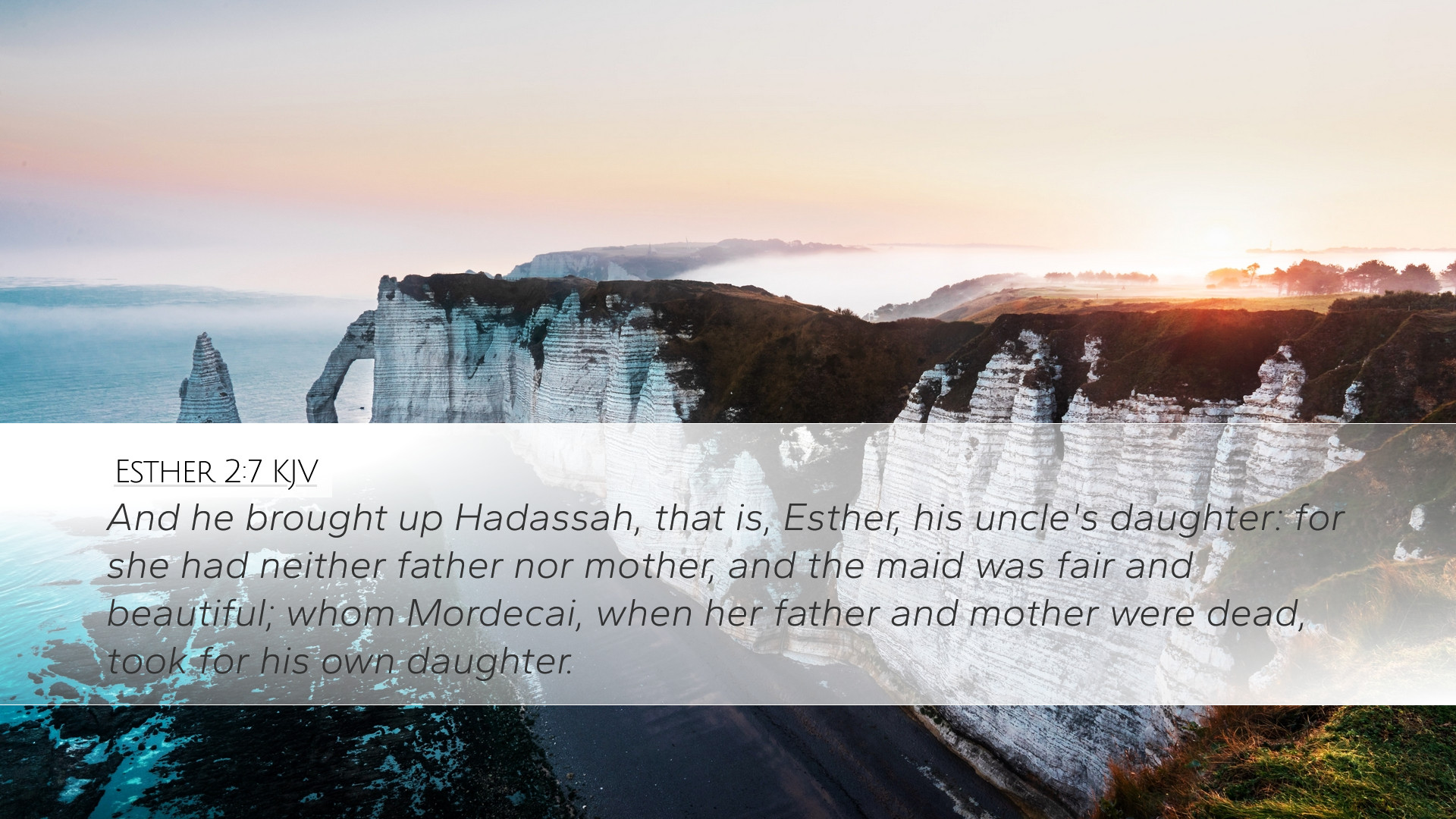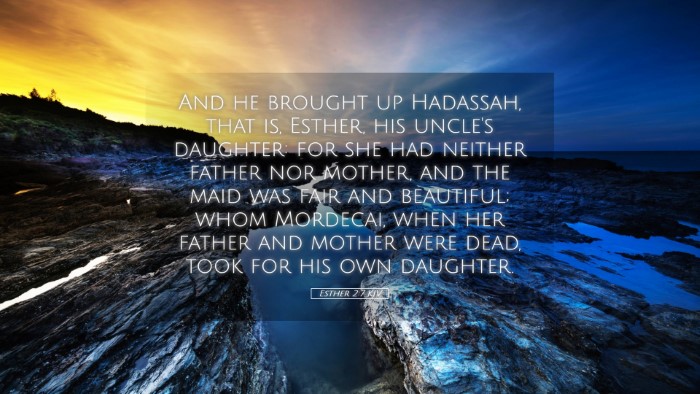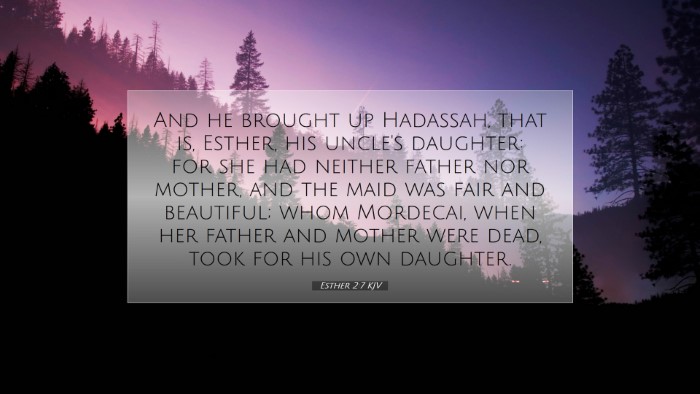Old Testament
Genesis Exodus Leviticus Numbers Deuteronomy Joshua Judges Ruth 1 Samuel 2 Samuel 1 Kings 2 Kings 1 Chronicles 2 Chronicles Ezra Nehemiah Esther Job Psalms Proverbs Ecclesiastes Song of Solomon Isaiah Jeremiah Lamentations Ezekiel Daniel Hosea Joel Amos Obadiah Jonah Micah Nahum Habakkuk Zephaniah Haggai Zechariah MalachiEsther 2:7
Esther 2:7 KJV
And he brought up Hadassah, that is, Esther, his uncle's daughter: for she had neither father nor mother, and the maid was fair and beautiful; whom Mordecai, when her father and mother were dead, took for his own daughter.
Esther 2:7 Bible Commentary
Commentary on Esther 2:7
Verse Context: Esther 2:7 states, "And he brought up Hadassah, that is, Esther, his uncle's daughter: for she had neither father nor mother, and the maid was fair and beautiful; whom Mordecai, when her father and mother were dead, took for his own daughter." This passage introduces Esther and immediately establishes her orphaned status and her relationship with Mordecai, setting the stage for her significant role in the unfolding narrative of the Jewish people.
Insights from Public Domain Commentaries
Matthew Henry’s Commentary
Matthew Henry emphasizes Esther's background as one of God's providence. The fact that she was orphaned is seen not as a hindrance but as a part of God’s sovereign plan. Henry notes that Mordecai’s adoption of Esther demonstrates a compassionate response to the needs of the vulnerable, highlighting the importance of family unity and the responsibilities that come with it.
- God's Providential Care: Henry points out that despite her traumatic past, Esther is introduced as “fair and beautiful,” suggesting divine favor. Her beauty becomes significant as it leads her to a place where God can use her for a larger purpose.
- Mordecai's Role: The relationship between Mordecai and Esther is crucial. He acts not just as a guardian but as an example of faithfulness and care, symbolizing the protective nature of familial bonds.
Albert Barnes’ Notes on the Bible
Barnes focuses on the description of Esther with attention to the terms "fair" and "beautiful." He argues that her physical attractiveness is underscored here, contributing to the narrative of her selection as queen. Barnes suggests that her appeal reflects an inherent social value within the story that leads to her ultimate role in the redemption of the Jewish people.
- Cultural Context: Barnes expounds on the cultural implications of beauty in ancient Persia, noting that physical attributes often determined a woman's status and opportunities. Esther's beauty thus serves a practical function within the storyline.
- Fate and Favor: He further discusses how Esther's rise from orphanhood to queenship exemplifies the theme of divine favor, enabling a seemingly lowly individual to fulfill a critical role in the history of Israel.
Adam Clarke’s Commentary
Adam Clarke provides a more detailed consideration of the characters involved, particularly Mordecai. He notes Mordecai's integrity in raising Esther, juxtaposing it with the broader societal challenges of the time, including exile and a loss of cultural identity. Clarke interprets Mordecai's care for Esther as both a familial duty and a reflection of Jewish values amidst adversity.
- Orphanhood: Clarke addresses the emotional depth of Esther's story as an orphan, positing that this aspect of her identity allows for greater relatability and insight about God's provision amidst vulnerability.
- Jewish Identity: He emphasizes how Esther’s upbringing reflects the necessity of maintaining cultural identity in a foreign land, reinforcing the narrative of survival and resilience.
Theological Implications
This verse invites rich theological reflection on several levels:
- Divine Sovereignty: The compelling narrative of Esther underlines the belief that God directs the affairs of humanity. It serves as a reminder that seemingly random circumstances may align to fulfill divine purposes.
- Human Responsibility: Mordecai's role illustrates the necessity of human agency within God's plan. His adoption of Esther speaks to the responsibilities we have toward those who are vulnerable in our communities, urging a response of love and care.
- Empowerment of the Marginalized: Esther's journey from an orphan to a queen represents empowerment, challenging the audience to recognize and advocate for the marginalized in society.
Application for Today
Pastors, students, and scholars can draw significant lessons for contemporary ministry and scholarship:
- Caring for the Vulnerable: The story encourages the church to be an advocate for orphans and strangers, reflecting God's heart for those in need.
- Understanding God’s Planning: In uncertain times, Esther’s example serves to remind believers of the comforting knowledge that God has a plan for each life, which may unfold in unexpected ways.
- Utilizing Gifts for a Higher Purpose: Like Esther, individuals are called to recognize their unique gifts and roles within God’s plan, potentially leading to transformative outcomes in their communities.
Conclusion
Esther 2:7 presents us with profound truths about identity, providence, and the interplay of divine purpose with human action. The commentaries of Henry, Barnes, and Clarke each provide pivotal insights that can deepen our understanding of Esther not just as a historical figure, but as a model for faithfulness, resilience, and advocacy in the face of adversity.


